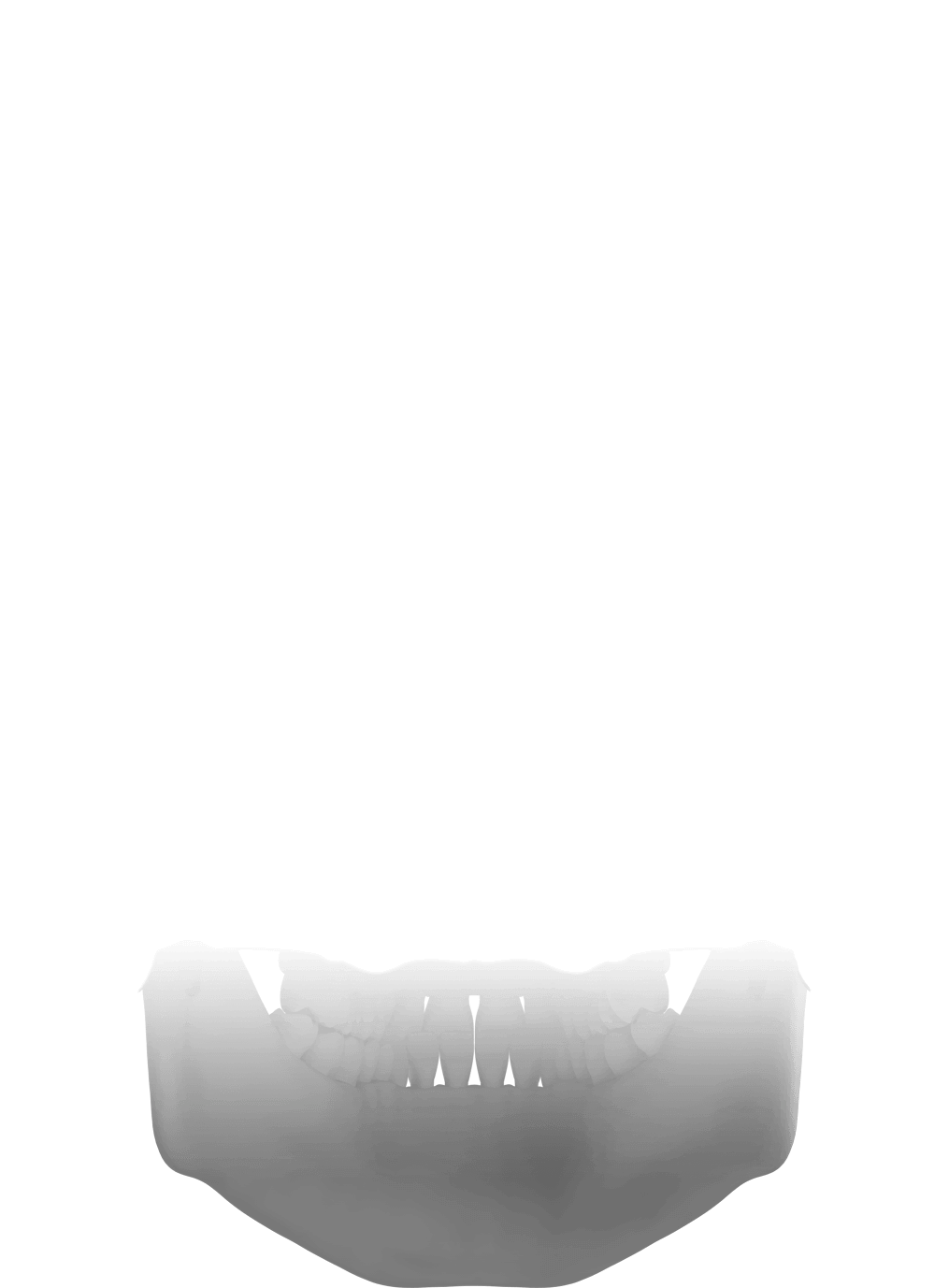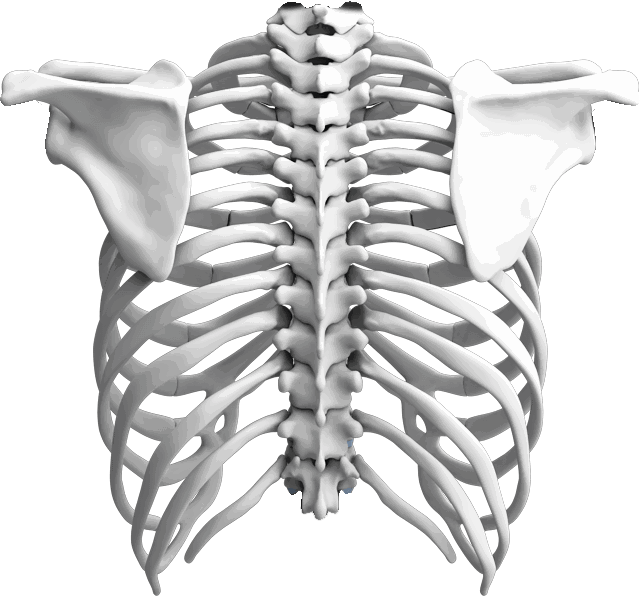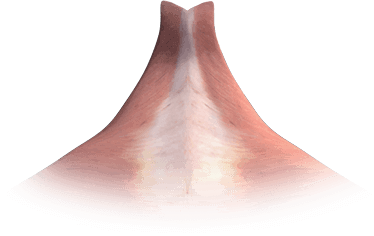Upper Neck 101
A Complex Problem
Injury, often during childhood (before the body fully develops) weakens the connective tissue, ligaments and muscles responsible for maintaining normal posture and alignment. The result is the misalignment you see here where the head, neck and atlas have shifted from their normal position. This causes the brainstem to be compromised, disrupting the communication between the brain and the vital organs, muscles, and tissues. The inflammation seen on your infrared scan is primarily caused by this component of the misalignment. This shift also creates muscle strain, which leads to postural distortion and body imbalance as the entire spine shifts off center in compensation for the displaced top vertebra (see “How Did I Get This Way?”. )
A Complex & Gentle Solution
Upper Cervical Care is a very precise system of analysis developed by Dr. B.J. Palmer, who conducted a fifteen year study at a research facility in Iowa to confirm the efficacy of the procedure. During that time, he saw patients from all over the world, who suffered from nearly every known health condition (including Dr. Charles Mayo and his family). Using the Palmer Analysis, we are able to calculate the precise reduction pathway and corrective force necessary to gently bring your head, neck and atlas back into alignment (represented by the red correction arrow when you click on the correction button). These highly sophisticated calculations allow us to correct this complex and delicate issue with very little force and no “twisting” or “popping” of the neck. As the correction in the upper neck is achieved, the irritation to the brainstem and its surrounding tissues is removed, restoring normal internal function to an optimum level and allowing the entire body to be brought back into balance. This is why people with problems even in the lower part of their body respond well to the Upper Cervical correction.
The Upper Cervical Specific Difference
The upper cervical misalignment is the most complex and difficult region of the spine to align, but when correction is achieved the results can be simply amazing. You will notice changes throughout your body as normal alignment and posture are restored. It takes a tremendous amount of training to deliver a quality Specific Upper Cervical correction.
Upper Cervical Analysis - The Upward or Downward Tilt
This animation demonstrates exactly how your neck, head and atlas are misaligned from their normal position as measured on your x-rays that were taken from the side.
The Amazing Upper Neck
The structural foundation of the body consists of the skull, first bone in the neck, and second bone in the neck. As with any other structure, the foundation of the body must be balanced. The primary function of the spinal column is to house and protect the brainstem and spinal cord, as well as provide structural support below the foundation for the weight of your body (i.e. head on the neck, shoulders/chest on the upper-to-mid back, and the lower torso on the low back). The spinal column is very good at its job until injury causes the foundation to shift. When the foundation shifts, the spinal column has to compensate, progressively weakening its ability to structurally support your body and protect the brainstem and spinal cord.
The top bone in the neck (atlas), in particular, is susceptible to injury because it is held in place only by muscle and features no interlocking joint or bony lock to hold it securely in place, as do all other bones in the body.
Three Dimensions of Misalignment
Because the upper neck is most vulnerable to injury, it misaligns in very complex ways. The animation here shows how your upper neck has shifted under your head in the second of the three directions of your misalignment.
How Did I Get This Way?
The vertebral arteries run through the openings on either side of the top bone. These arteries account for roughly 30% of the blood supply to your brain. The misalignment, in this case, creates a sheering stress on the arteries similar to stretching a rubber band past its normal elasticity, decreasing the blood supply to the brain through the arteries in the process.
Overview
The misalignment you see is the result of one or more injuries in your past. Many injuries can be traced as far back as childhood: That header off the top bunk, a tumble down the steps, the fall off the bike, hayloft, or backyard tree. Or perhaps it was that teenage gymnastics injury or auto accident? Think back and you’ll probably come up with a few possibilities of your own.
Regardless of the cause, a vast majority of people are left with some sort of upper neck misalignment and posture distortion by the time they reach adulthood. Keep in mind that these misalignments often remain pain-free until a more recent injury occurs. Or sometimes, simply having the underlying misalignment and body imbalance present for years will catch up to us as spinal joints and discs degenerate prematurely (see “How Does This Affect My Health”). This is similar to what happens with tooth decay. A cavity can exist for years before the tooth causes pain.
The Nervous System "Grand Central"
The lower end of the brain is called the brainstem because it descends down into the upper neck. Every nerve that travels down the spinal cord has to pass through the fragile donut shaped vertebra that wraps around the brainstem called the atlas. For this reason, the upper neck is our neurological “Grand Central Station.” Here’s why:
Posture And Body Balance
The lower brainstem controls posture and balance. Misalignment and stress in the upper neck causes the muscles along each side of the spine to pull unevenly and shift the entire body off center. (See “The Bigger Picture” to learn how stress on these posture control centers affect the entire body.
Blood Pressure, Respiration and Heart Rate
The neurological centers for control of these body functions are located in the lower brain stem and can be adversely affected by upper neck misalignment. Recent research has proven the Specific Upper Cervical correction helps people with high blood pressure. Google “upper cervical” and “blood pressure” to view the results of this research.
Sleep / Mood
Serotonin is a chemical produced in the lower brain stem. Serotonin influences various functions, including regulation of mood, sleep, appetite, muscle contraction, and some cognitive functions including memory and learning. Upper neck misalignment causing stress on the lower brain stem can have a dramatic affect on a person’s energy and overall sense of “aliveness” as is the case with Chronic Fatigue Syndrome and Fibromyalgia.
Immune Function
The Autonomic Nervous System controls all of the body functions that we don’t have to think about. The Sympathetic Nervous System is that part of our Autonomic Nervous System that becomes more active during times of stress and is often called the fight-or-flight response. Upper neck misalignment creates long-term activation of the Sympathetic Nervous System which is proven to suppress the body’s Immune System.
Digestion
The Vagus nerve is very influential in regulating digestion and elimination. This important nerve is often affected by misalignment of the upper neck because it passes right next to the atlas vertebra as it comes down from the brain.
Facial Problems
Cranial Nerve dysfunction can result in problems such as Trigeminal Neuralgia, Bells Palsy, Meniere’s Disease, Sinus Problems, Headaches, Ear Pressure, Dizziness, etc. Patients with these problems often respond to a Specific Upper Cervical correction since cranial nerves have tracts that descend into the upper neck. Most recent research is beginning to show how upper neck misalignment impedes cerebral spinal fluid flow and blood flow in and out of the brain!
Migraines and Other Headaches
When the brainstem begins to malfunction, the blood vessels that surround the brain begin to swell, resulting in the nerve fibers attached to the vessels becoming over-excited, leading to pain and/or sensitivity to light/sound. A chain reaction then occurs that may have a wide ranging effect on the body, as the increased activity of the nerve system causes heart rate to increase and abnormal breathing. It also leads to the slowing down of digestive processes, which contributes to nausea and vomiting.
The Bigger Picture
The brainstem subluxation has a global affect on the body. When the head and neck are misaligned due to injury, the first cervical vertebra no longer positions squarely under the head. In addition to compromising the part of your body (the brainstem) that regulates all of the other vital organs, muscles, and tissues, this shifting of the atlas also causes a tremendous amount of physical strain. Muscles that run along one side of the body pull harder than muscles on the other side. The result is the picture you see here.
Notice the short leg, uneven hips, high shoulder and head tilt. Look closely at your friends and family as they face you and you may be able to tell if they should be referred for an evaluation. When you click on the “Show Correction” button you will see how the Upper Cervical specific correction is a correction of the entire spine from the top down!
Body imbalance has a very negative long term effect on structural stability. We are all born with a structural support system to help us bear the weight of our heads on top of our necks, the weight of the shoulders and chest on the upper and mid spine, and the weight of the rest of the torso on the lower part of the spine. These structural supports consist of the structural spinal support (banana) curves (in the neck, upper back, and lower back) and the discs in between the vertebrae. When you lose foundational alignment and the entire body shifts, you will lose the curve in the neck in compensation. Once the curve in the neck is lost, the curve in the lower back will follow suit. Then, the curve in the upper/mid back will have to change. The changes in the curves force the discs in between the vertebrae to bear more weight. Since they are not designed to play that big of a role, they start to break down much faster than they ever would have worn down with age. As the discs break down, the bones above and below them begin to grow together, fusing over time for stabilization (one bone is better than two bones with a weak, degenerated disc in between). As the bones grow together, eventually bone spurs form to complete the fusion of two bones into one. This is the process commonly known as degeneration or arthritis.
When the body’s weight is not distributed evenly across the discs, not only will it stimulate the degenerative process, but it will also make you more susceptible to bulges, herniations, or ruptures of the discs as the pressure/weight becomes too much to withstand. Even a closing down of spinal nerve canals (stenosis) can result. Just as driving your car with the front end out of alignment causes premature tire wear, long term body imbalance causes your body to age faster. The difference between a 75 year-old on the golf course and a 75 year-old pushing a walker is structural integrity/balance!
How Does This Affect My Health?
The brainstem controls and regulates every function of the body, most of which we don’t consciously think about, such as heart rate, breathing, digestion, immune response, etc. That is why the brainstem is the very first body part to develop in the mother’s womb.
The skull and the upper cervical vertebrae are two of the very next body parts to develop in order to house and protect the brain and brainstem. The brainstem, which is the nervous system’s “Grand Central Station”, passes through the first cervical vertebra. If the top bone is misaligned, it is akin to placing a dimmer switch on the most important of your body. Christopher Reeve fell off of a horse, landed on his head, and so severely jammed the atlas underneath his skull that his bodily functions shut down. Though the traumas we experience are not nearly as severe, and thus do not produce as pronounced or immediate affects, they still take their toll. The signs and symptoms begin slowly, becoming more significant as time goes on until the body’s ability to fully heal itself is restored.
- The misalignment of one of the top two bones in the neck that protect the brainstem causes the brainstem to be compromised, weakening its ability to normally regulate your internal function. If the brainstem has been compromised, any part or parts of the body may begin to function abnormally. Abnormal function in the brain and the body leads to abnormal symptoms and conditions. Allergies, Auto-immune conditions, digestive problems, headaches, heart conditions, pain, vertigo, etc. may result.
- Body imbalance creates an ongoing structural and neurological stress to the body. The more consistent the stress and strain on the bones, muscles, joints, and ligaments of the body, then the faster the body will break down and the more likely you are to develop the signs and symptoms thereof, such as pain (throughout the body in some cases), numbness, tingling, neuropathy, weakness, disc injuries (bulge, herniate, rupture), etc.
- Long term body imbalance causes degeneration (aka structural breakdown). Arthritis is the more common term for this process of breakdown. As degeneration becomes advanced, the vertebrae themselves encroach upon the spinal nerves causing them to slowly lose their ability to transmit vital brain messages. Doctors refer to this condition as spinal stenosis.
Is Your Spine Older Than You?
The human body is designed to live to be over a hundred years old! Unfortunately, a majority of people are robbed of their “golden years” by a spine that ages prematurely. Honestly, most people understand more about taking care of their teeth than their spine! The progression of spinal degeneration is explained below. Any idea where are you at?
Normal Cervical Spine
The first and most important job of the spine is to house and protect the Nervous System. Normal spinal curves and healthy discs provide maximum protection and optimal function of the nervous system. The process of spine and nervous system breakdown and decay is called Degeneration.
Characteristics of a Normal Cervical Spine include:
• Healthy
• Pain Free
• Physically Fit
• Stress Free
Phase I: 5-15 Years of Adaptation
Uncorrected spinal trauma results in loss of normal curve, disc narrowing and subtle spine and nerve malfunction. Because the body is so adaptable, this early phase can exist without the warning of pain or other symptoms. If left uncorrected, the degeneration continues.
Common symptoms of Phase I Degeneration include:
- Headaches
- Neck Pain
- Strained Muscles
- Shoulder Tension
Phase II: 15-30 Years of Adaptation
Recognized on x-ray by visible bone spurs and rough edges of the vertebrae. Abnormal bony growths distort the shape and function of the vertebrae and cause stress to discs, joints and ligaments. Breakdown of these soft tissues results in lack of normal joint movement, inflammation and interference to nerve flow.
Common symptoms of Phase II Degeneration include:
- Arthritis
- Disc Disease
- Degenerated Joints
- Fatigue
- Joint Pain
Phase III: 30+ Years of Adaptation
A lifetime of neglect may cause the eventual fusion of the malfunctioning joints. Atrophy, permanent nerve damage, and soft tissue degeneration are prevalent. Reduced mobility and impaired nervous system function diminish one’s quality of life.
Common symptoms of Phase III Degeneration include:
- Chronic Pain
- Irreversible Damage
- Spine Disease (stenosis)
- Relief Care Only
Remember: The difference between the 75 year-old swinging a golf club vs. the one pushing a walker? A spine that aged prematurely! An old saying in our profession could be adapted to read: “Upper Cervical Care adds years to life and life to years!”

432A W Mountain St
Kernersville, North Carolina
27284













































































